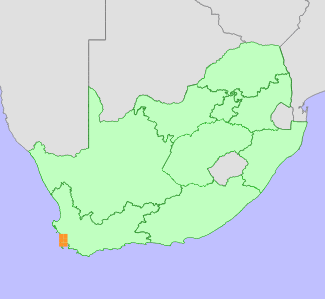|
Scientific Name | Leucadendron levisanus (L.) P.J.Bergius |
Higher Classification | Dicotyledons |
Family | PROTEACEAE |
Common Names | Cape Flats Conebush (e) |
National Status |
Status and Criteria | Critically Endangered A2ace+4ce |
Assessment Date | 2020/07/18 |
Assessor(s) | A.G. Rebelo, R. Koopman, D. Raimondo, J. van der Merwe & H. Mtshali |
Justification | Leucadendron levisanus is endemic to the Cape Flats and has a restricted distribution range, with an extent of occurrence (EOO) of 1551-1716 km², and an area of occupancy (AOO) of 144-148 km². This species was once extensive and common but has lost the vast majority of its habitat to urban and agricultural development. It remains extant at only 10 small severely fragmented subpopulations that occur in remnant fragments of vegetation. From herbarium records and recent monitoring data a minimum of 14 other subpopulations have gone extinct, of which four have been lost since 1990. The population has declined by 90% in the past two generations and is likely to continue to decline in the next 15 years. It therefore qualifies for listing as Critically Endangered under criterion A. |
Distribution |
Endemism | South African endemic |
Provincial distribution | Western Cape |
Range | This species has a limited distribution range in the south western Cape, South Africa, where it occurs from Mamre to the Cape Flats. |
Habitat and Ecology |
Major system | Terrestrial |
Major habitats | Hangklip Sand Fynbos, Cape Flats Sand Fynbos, Atlantis Sand Fynbos |
Description | It occurs in or adjacent to seasonally damp areas, in sandy soils, 20-200 m. Mature individuals are killed by fires, and only seeds survive. Wind-dispersed seeds are stored in fire-resistant inflorescences, and released after fires. It is dioecious, with insect-pollinated male and female flowers occurring on separate plants. It has a generation length of 10-15 years, and plants senesce if vegetation is left unburnt for over 15 years. |
Threats |
| Habitat loss to urban development and agricultural practices including draining of wetland sites for ploughing, canalization, altered drainage, and damming for irrigation has severely transformed and disturbed this species' habitat. At leat 92% of its habitat is irreversibly modified, and there is slow, ongoing loss mainly in northern part of the range.
Plants remain in a small remnants of natural vegetation and are threatened by too infrequent fire and mowing under power lines and road verges. The former results in loss of the seed bank as plants senesce and die, and the latter destroys adult plants with released seeds either eaten by rodents or failing to establish when germinating. Increased molerat activity associated with disturbance has been observed.
The fragments are also threatened by increasing alien invasive plants (particularly Acacia and Leptospermum species), groundwater extraction, road construction, pollution from sewage spills, infrastructure (power lines and pipe service) maintenance, and overgrazing. Plants are over-harvested for firewood by overnighting vagrants, and browsed by sheep. Strict conservation measures are required to prevent the extinction of this species. |
Population |
Leucadendron levisanus was once abundant, but its habitat has been severely transformed. It remains extant at 10 subpopulations all of which occur on isolated remnants of lowland Fynbos. Monitoring during the Protea Atlas Project (1992-2002) followed by ongoing monitoring by the Custodians of Rare and Endangered Wildflowers Programme (2003-2020), shows that the population has declined from an estimated 4130- 5000 mature individuals in the early 1990s to 430-480 mature individuals between 2018 and 2020, this equates to a 90% decline in the population over two generations. The majority of remaining subpopulations are small, consisting of fewer than 50 individuals, only the population at Milnerton Race Course has more than 100 plants. It is likely that the majority of these remaining subpopulations will continue to decline and be lost within the next 20 years unless extensive reintroduction work is undertaken.
|
Population trend | Decreasing |
Conservation |
| This species occurs in Blaauberg Nature Reserve but the subpopulation is small and not likely to be viable. None of the other sites are formally conserved. There are attempts to re-establish the Fish Hoek plants at Rondevlei and at Tokai. From restoration work done to date it appears that the plants may senesce as early as 10 years and so this species appears to require shorter fire cycles than other proteacea species. |
Assessment History |
Taxon assessed |
Status and Criteria |
Citation/Red List version | | Leucadendron levisanus (L.) P.J.Bergius | CR A4c | Raimondo et al. (2009) | | Leucadendron levisanus (L.) P.J.Bergius | Endangered | Hilton-Taylor (1996) | | Leucadendron levisanus (L.) P.J.Bergius | Endangered | Hall et al. (1980) | |
Bibliography |
Goldblatt, P. and Manning, J.C. 2000. Cape Plants: A conspectus of the Cape Flora of South Africa. Strelitzia 9. National Botanical Institute, Cape Town.
Hall, A.V., De Winter, M., De Winter, B. and Van Oosterhout, S.A.M. 1980. Threatened plants of southern Africa. South African National Scienctific Programmes Report 45. CSIR, Pretoria.
Hilton-Taylor, C. 1996. Red data list of southern African plants. Strelitzia 4. South African National Botanical Institute, Pretoria.
Manning, J.C. and Goldblatt, P. 2012. Plants of the Greater Cape Floristic Region 1: The Core Cape Flora. Strelitzia 29. South African National Biodiversity Institute, Pretoria.
Raimondo, D., von Staden, L., Foden, W., Victor, J.E., Helme, N.A., Turner, R.C., Kamundi, D.A. and Manyama, P.A. 2009. Red List of South African Plants. Strelitzia 25. South African National Biodiversity Institute, Pretoria.
|
Citation |
| Rebelo, A.G., Koopman, R., Raimondo, D., van der Merwe, J. & Mtshali, H. 2020. Leucadendron levisanus (L.) P.J.Bergius. National Assessment: Red List of South African Plants version 2024.1. Accessed on 2025/10/18 |
 Comment on this assessment
Comment on this assessment

